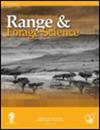Do native grasses emerge and establish in areas rehabilitated using vetiver grass?
IF 1.9
4区 环境科学与生态学
Q3 ECOLOGY
引用次数: 0
Abstract
Species-rich grasslands provide important ecosystem services, and in South Africa, approximately 40% of these grasslands are degraded. Vetiver grass (from India) is often used during rehabilitation efforts to restore soil function without a thorough understanding of the potential negative ecological impacts. Hence, a study was initiated to investigate vetiver’s ecological impacts during grassland rehabilitation. Firstly, a field survey was conducted using a contiguous quadrat method to evaluate the extent of grass secondary succession in these rehabilitated sites. Secondly, the effect of vetiver competition and seed sowing method on the recruitment of two native grasses (Eragrostis curvula and Megathyrsus maximus) was examined using pot trials. The field survey results showed no evidence of grass secondary succession, but rather the abundance of bare ground around vetiver, and a marked increase in grass species richness with increasing distance from planted vetiver. Subsequently, in the pot trial, vetiver facilitated emergence in both native grasses, and soil surface sowing of indigenous grass seeds showed greater emergence than other sowing methods. However, vetiver inhibited native grass seedling establishment, even when root competition was excluded. This study suggests that areas rehabilitated using vetiver are unlikely to become productive grasslands with good grazing, because vetiver inhibits colonisation by native grasses.在使用香根草修复的地区,原生草是否会出现并生长?
物种丰富的草原提供了重要的生态系统服务,而在南非,大约40%的草原已经退化。香根草(来自印度)经常被用于修复工作,以恢复土壤功能,而没有彻底了解潜在的负面生态影响。因此,本研究旨在探讨香根草在草地恢复过程中的生态影响。首先,通过野外调查,采用连续样方法评价了草地次生演替程度。其次,采用盆栽试验研究了香根草竞争和种子播种方式对两种乡土草(Eragrostis curvula和Megathyrsus maximus)植株招募的影响。野外调查结果显示,草的次生演替不明显,但香根草周围的裸地丰富度较高,草的物种丰富度随距种植香根草距离的增加而显著增加。随后,在盆栽试验中,香根草促进了土生草和土生草种子的出苗,土生草种子地表播种比其他播种方式出苗更明显。然而,香根草抑制原生草幼苗的建立,即使在排除根系竞争的情况下。这项研究表明,使用香根草恢复的地区不太可能在良好的放牧条件下成为高产草地,因为香根草抑制了原生草的定植。
本文章由计算机程序翻译,如有差异,请以英文原文为准。
求助全文
约1分钟内获得全文
求助全文
来源期刊

African Journal of Range & Forage Science
ECOLOGY-ENVIRONMENTAL SCIENCES
CiteScore
4.00
自引率
14.30%
发文量
35
审稿时长
>12 weeks
期刊介绍:
The African Journal of Range & Forage Science is the leading rangeland and pastoral journal in Africa. The Journal is dedicated to publishing quality original material that advances rangeland ecology and pasture management. The journal aims to publish research of international importance from any region, but as an African journal, we are particularly interested in research from Africa and relevant to the continent. The Journal promotes both science and its application and authors are encouraged to explicitly identify the practical implications of their work. Peer-reviewed research papers and research notes deal primarily with all aspects of rangeland and pasture ecology and management, including the ecophysiology and biogeochemistry of rangelands and pastures, terrestrial plant–herbivore interactions (both domestic and wild), rangeland assessment and monitoring, effects of climate change on rangelands, rangeland and pasture management, rangeland rehabilitation, ecosystem services in support of production, conservation and biodiversity goals, and the identification and development of intensive and semi-intensive pasture and forage resources to meet livestock production needs. Articles highlighting transdisciplinary linkages among biophysical and social sciences that support management, policy and societal values are particularly encouraged. The Journal includes relevant book reviews and invited perspectives that contribute to the development of range and forage science. Letters to the editor that debate issues raised in the Journal are acceptable. The African Journal of Range & Forage Science is the official journal of the Grassland Society of Southern Africa.
 求助内容:
求助内容: 应助结果提醒方式:
应助结果提醒方式:


